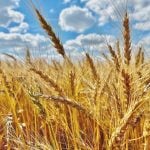The first question that comes up when cover crops are discussed is “Do they pay?” Net returns from cover crops will be determined by what goals were set, what species were grown and other intrinsic benefits from the cover crop.
In any business, net profit is the difference between costs and revenue. The two ways to increase profit are to increase revenue or decrease costs. If the two can be done at the same time, more profit is made. Simple, right?
In a livestock situation, revenue can be generated by grazing or haying the cover crop. Haying may seem like a withdrawal from the nutrient cycle, but it may fit the set goals. Days of grazing or tonnes per acre are easy to measure and value, so it’s easy to calculate the revenue generated. Costs are in place. Profit can be determined.
Read Also

Claas brings 1000 Series SP forage harvesters to Canada
In mid-August, Claas unveiled its new line of Jaguar forage harvesters at an event in Visalia, California, deep in the heart of that state’s dairy region.
- Read more: Good reasons to plant cover crops
The revenues that are harder to measure are the soil health and the nutrient cycling aspect of cover crops. That is where producers without livestock have trouble putting an economic value on including cover crops in rotations. What is the value of reducing hard pan soils? How much profit can be generated by reclaiming sour or saline patches? What’s the return on investment from having plants growing in the soil throughout the growing season, feeding the soil biology? It’s difficult to come up with quick answers.
It’s easier to put a value on a legume cover crop with the goal of fixing nitrogen. By using a feed test to estimate the nitrogen contained in the cover crop, it’s possible to estimate nitrogen available for the next crop. There are some variables like how well was the legume nodulated, how lignified was it, is it being incorporated, soil moisture condition, and how is the soil microbiology working. The amount of nitrogen available for the next crop can be multiplied by the value of nitrogen per pound to calculate the value of the legume crop.
But how does one value a cover crop like diakon radish, used to break up hard soils? Crops grown afterwards may respond to the soil’s improved rooting characteristics. Radish will scavenge nutrients deeper in the soil profile and redistribute them in the top part of the soil. Radish roots rotting in the spring will help warm the soil, and if minimum-tilled into the residue, radish will result in extended weed-free conditions for the seedling crop.
Another property that’s hard to value is increasing organic matter. Once a cash crop is harvested, there are usually no living plants on a field in the fall. Adding a post-harvest cover crop means plants are photosynthesizing, pumping sugars into the soil in the fall. The plants continue to sequester carbon, building organic matter.
Higher organic matter will allow quicker absorption of water, allow the soil to retain more water and improve nutrient cycling, root structure and nutrient efficiency. It will also protect the soil from erosion and sustain more soil microbes.
Sharpen those pencils
The first cost to consider is the cost of the cover crop seed. Costs can range from $2 to over $80 per acre. Species used, seeding rate, on-farm seed supply, and seeding methods all contribute to the costs.
When a small-seeded cover crop is mixed in with a cash crop and seeded at the same time, costs are low. Seeding a large-seeded species on its own costs more. On our farm, using a full-season cover crop blend that we green feed, we include millets, Phacelia, tuber plants, and annual legumes, which normally costs around $28 per acre. Seeding bullseye radish at six pounds per acre would cost just under $20 per acre. Adding one pound per acre of Persian clover to a spring-seeded crop costs around $4 per acre. These costs don’t include seeding.
There may be other management costs. For example, if daikon radishes are seeded too early, they will bolt. A bolted radish field will be difficult to deal with the next year unless a disc opener seeder is used. The field may have to be clipped or mowed. It’s important to know each species’ growth characteristics.
Until a production cycle is completed, the direct economics of cover cropping can be described as fuzzy. Improving soil health, increasing organic matter and improving soil microbe diversity all have long-term implications but no direct revenues. The value of nutrient cycling and breaking up of hard pan can be seen quickly. Nitrogen fixation is the easiest to measure and link to an actual cash value. After the production cycle is completed, and microbes can do what they do, results become more evident.
We’ve noticed our crops are healthier and require fewer inputs. Cover crops have improved our net income.















